I (Greg) didn’t finish the Montane Yukon Arctic Ultra (MYAU) race in February 2022, due to frostbite in some toes that were spotted at the checkpoint around the 60-mile mark. This was short of the 100-mile finish I was aiming for.
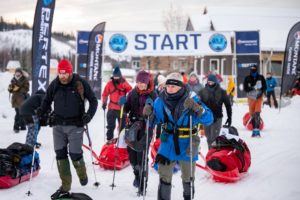
The MYAU is an annual event (though cancelled in 2021 due to COVID-19) that bills itself as the world’s toughest and coldest ultra race. An “ultra” is any race that is longer than a marathon. MYAU allows competitors either on foot, on bike, or on skis.
What makes it so tough? First is the necessity to haul lots of gear. My pulk (i.e., sled or sledge) weighed 86 pounds (39kg) including 8 liters of energy drink, a full arctic sleeping system (-60 sleeping bag, R6 sleeping pad, bivvy bag, and tarps), a cooking system (stove, fuel, pots, fire starter, and enough food for 48 hours), various first aid and emergency gear (saw, compass, whistle, mylar emergency bivvy bag), big overshoes (i.e., boots), snacks, and lots of clothing. A SPOT tracker plus a Garmin InReach satellite communication system. Also a headlamp and spare, and several spare batteries.
My spare clothing included two full changes of all my layers of clothing, plus extras. Extras included over a dozen pairs of gloves, mitts, and liners, neck gaiters, balaclavas, fleece jacket, anorak, and an 850-weight down parka. The idea was to be able to swap out anything that got damp, and to add or remove layers as temperature and conditions required.
Hauling the pulk (i.e.,. 5′ plastic sled attached via a shoulder & belt harness) was physically challenging. It’s not just regular running or walking.
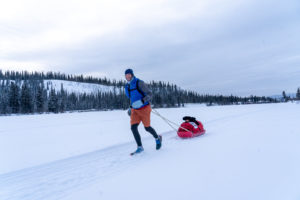
The MYAU is also challenging due to the weather. It can be extremely cold during the race, and 2022 had some tough weather. The race started at 10:40am on Thursday February 3. It was lightly snowing with moderate wind (5-10 mph). Temps were supposed to warm up somewhat, but never really did – it was around -10F (-23C).
The race follows the same course as the Yukon Quest. It begins in Whitehorse (Shipyard Park) and drops almost immediately onto the frozen Yukon River, heading north. The trail turns west under the Takhini River Bridge on the Klondike Highway, and follows the Takhini River to the Overland Trail. The Overland Trail used to be the road from Whitehorse to Dawson. It’s very scenic. The 100-mile race ends in Braeburn, while the 300-mile race continues further north (every second year there is a 430-mile variation of the MYAU).
My journey started out just fine. From the start of the race, I was jogging along with my pulk, gradually removing outer layers as I warmed up. Surprisingly I was the only one of around 26 people on foot who ran. The others were walking, except for the one competitor on a bike who passed me after a few miles.
I had trained for the MYAU extensively. I have run some 100-mile races before, and I do at least 1 mile of running (or, rarely, walking) outdoors every day. I had trained for 2-1/2 months with the pulk, loading it up with 50 pounds or so of gear. I even did a 44-mile training run a few weeks before.
I knew this would not be a running race. 100-milers never are, for me. I like to run (jog) when I can, walk up hills, and walk when needed to rest. I was also prepared to take a nap for several hours, perhaps at the Dog Grave Lake checkpoint (where, instead, I was withdrawn due to my frostbite).
Running 20+ miles to the first checkpoint at Muktuk Lodge on the Tahini River presented no substantial challenges other than the weather. The trails had been groomed several times, and thanks to a temporary warm-up in the weeks before the race there was a solid base. There was a little fresh snow, but otherwise the trails were close to perfect: firm, wide, well-marked, and quite flat (other than slight hills when the trail was on the river bank).
It was still quite slow going. I arrived at Muktuk around 5:30pm, having run nearly 21 miles. I took a nice break for the required medical check, a new SPOT transmitter (my original one was not tracking), a snack, and a nearly complete change of clothing. I didn’t finish my first marathon distance (26 miles) until around 7 hours after start. Overall, I was travelling slightly better than half my usual marathon pace. This was mostly due to moving slowly while pulling the pulk, but also due to frequent stops.
My main stops while travelling the first sections of the race were for hydration or gear adjustment. For hydration, I had these great thermal bottles. Each holds 1 litre of hot liquid, and I had mixed boiling water with TailWind for my drink of choice throughout the day. They were so hot that I would transfer half a litre to a smaller Nalgene-type bottle, to drink from (I held that smaller bottle in a pocket of my running vest).
I would also stop to take off or put on gear – gloves, a vest, over-mitts, etc. This was because I was warmed up, but the temperature was getting colder and there were occasional sections of high winds. The snow continued, and was sometimes quite heavy. It wasn’t completely pleasant for travel, but it was tolerable: not incredibly cold, the trail was good, and the wind was mostly not very strong.
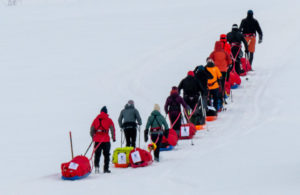
From Muktuk, the trail continued on the Takhini River for another 10 miles to the start of the Overland Trail. The trail then wound upwards for a mile or two to a parking lot with an RV for anyone who needed aid. This aid station, unlike Muktuk, was only for people who needed help and were likely to drop out.
The snow continued, as I headed up the Overland Trail. It was fully dark, and I had not seen sign of other competitors since just after Muktuk. There, I was the first runner to arrive (the bike had arrived and departed well before I did). Three or four other runners came in while I was at the checkpoint, and two left before I did.
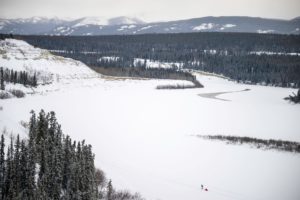
I passed one of those runners shortly after departing Muktuk. He was moving well, and it took me over a mile to catch up. I didn’t see the other runner until many hours later, perhaps around midnight. This was Kevin, who won the 100-miler the year before and this year ran the 300-miler. He was moving a little more slowly than I was running, but we were both taking frequent breaks.
Eventually I was in lead for an hour or so, but then was passed. I had been slowing down, and was walking much more than running. I would even take short micro-rests: leaning over, stretching, hydrating, etc.
The snow had continued, and by midnight there was perhaps 4-5 inches of fresh snow on the ground. The temps had continued to drop, to around -25F (-32C). Occasional light wind, and constant snow that was occasionally heavier and sometimes lighter.
I had maintained a bright outlook, and wasn’t alarmed at my slowing pace – it was expected, and typical of my other ultra races. The pulk was a huge burden, and it was an extreme physical challenge to keep it moving. At those temperatures, snow is not slick: it’s rather abrasive. Kevin was breaking trail, but it was still tough going to pull the pulk. It was much worse, of course, when going uphill. My pulk was attached to my harness by two long bungee-type cords within 6′ CPVC (i.e., plastic-like) 1/2″ tubes. This was a great system, but when going uphill the cords tended to stretch then compress, sometimes whacking the pulk into the back of my legs. I think this was generally easier than to have rigid poles, but I’m not positive.
On the overnight, Kevin was getting further ahead of me, and the snow was heavier for several hours. Eventually his track and the track of the bicyclist were covered in, and I was was pulling through 4-5 inches of fresh, powdery, and not-at-all slippery snow.
I had changed my socks at Muktuk, but was planning on wearing the same sneakers for the whole race. I have run in these in all temperatures, down to -45. I knew most of the other runners were wearing sneakers. I had very heavy wool socks (Smartwool), and also plastic shopping bags between the socks and shoes to keep the moisture from getting to my socks. This all worked pretty well.
My basic gear plan was for a nearly complete change of clothing (except for bottom underwear and tights unless needed) at Muktuk then again at the Dog Grave Lake checkpoint. Plus socks in-between each, as well as changing gloves, headwear, etc. as needed.
My right toes got cold somewhere on Overland Trail. I wiggled and stretched and they seemed to warm up. Later I changed socks, and could not get a chemical toe warmer to stick to my socks – the glue doesn’t seem to work when it’s cold.
I carried on.
Eventually it got light out, though still snowing at around 10am. I had not seen anyone since 2:30am or so. I thought someone might pass me from behind, or a snow machine (i.e., race crew) would pass by. That could pack the trail and make it easier to pull the pulk.
I stopped sometime around noon to put on new socks. My right toes felt ok, but looked a little water-logged. My left toes were quite cold, and just were not warming up. So, I instead wore my big overshoes with a new dry pair of running shoes inside.
When I took my old shoes off, after over 24 hours on the trail, they were solid ice! I could not move them at all to get back on my feet, even if I tried. My belief is this was purely due to snow melting on them as I ran for hour after hour. My socks were a little damp, but not soaked through. So luckily my feet were not particularly wet, just slightly damp and rather cold.
The new overshoes were much more comfortable. They are unsuitable for running, but I was really just doing an occasional trot as I headed towards the Dog Grave Lake checkpoint. They didn’t slow me down.
I was using my phone with Strava as a tracker, and sometime around the 40 mile mark (i.e., the middle of the Overland Trail) it started to lose touch with reality. I knew I had gone at least 50 miles, and the CP was close to mile 60, but Strava was telling me I hadn’t yet gone 50.
Theoretically I could have spent time with my InReach to figure out my location on a map, but stopping in those temperatures was something to be minimized – and it didn’t really matter how far it was to the checkpoint: I would keep going.
The last 8-10 miles into Dog Grave Lake were almost entirely uphill, including some rather steep sections. This was very slow going – under 2 m.p.h., rather than 4-5 m.p.h. at the start of the race, and 3+ for the first parts of the Overland Trail. This is slower than a regular walking pace! I took many micro-breaks, and managed to keep a fairly bright outlook.
I knew the checkpoint would eventually be reached. My plan was to bivvy (i.e., climb into my one-person sleeping system) and rest for several hours. I would eat some instant noodles, drink some extra TailWind, dry and warm my feet, have fresh and warm clothing, and then continue on the remaining 35 or so miles to Braeburn.
I reached the Dog Grave Lake checkpoint at around 2:30pm, nearly 28 hours and 60 miles into the race. I was the third person (and second runner) to arrive. The crew there was great, and very caring. They showed me where to bivvy, offered snacks, and asked how I was doing. Within a few minutes, I was in the medical tent for the required medical check.
The check includes looking at (bare) feet, hands, and head, especially for frostbite but also for any other signs of distress or injury. For example, a big warning we all got was not to get too sweaty: when you sweat too much, all the gear stops working well, and that can be a rapid path to hypothermia. This wasn’t an issue for me, since I had managed hydration and perspiration pretty well, throughout the race.
The race medic immediately diagnosed frostbite in the three biggest toes on my right foot. They were quite cold, grey-white, and had no feeling. The other toes, on both feet, had frost nip: cold and tingly and rather red, but not frozen.
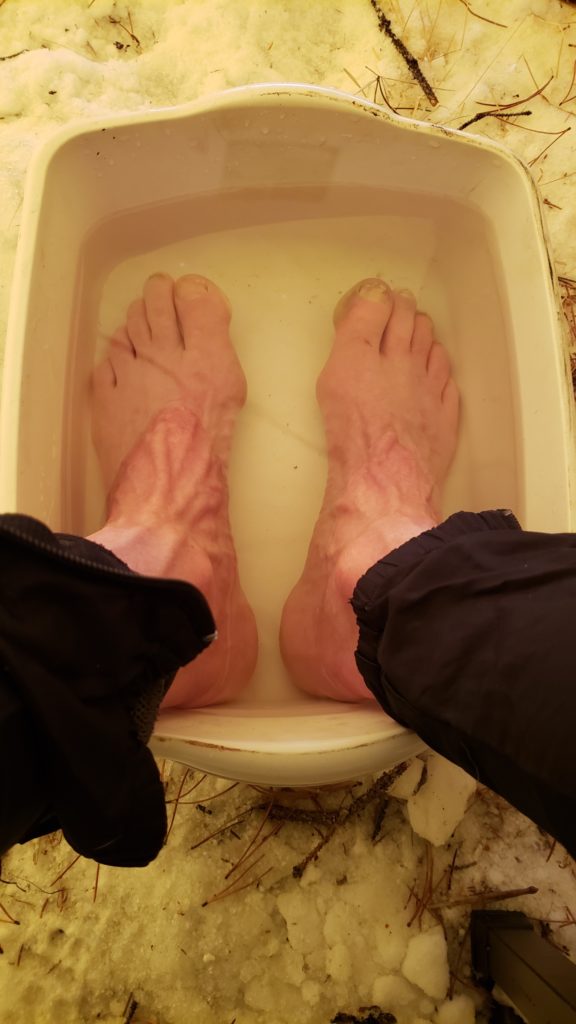
My race was over. Frostbite is one of the medical conditions that requires immediate non-voluntary withdrawal from the race. Instead of heading towards Braeburn, I was headed for a snow machine ride back to the parking lot at the start of the Overland Trail.
This wasn’t how I had envisioned my race ending, but I accepted it. I had run around 60 miles through some very challenging winter conditions. Other than my shoes and feet, all of my planning and gear had worked very well. I was physically exhausted, and mentally over-tired, but prepared to continue on after a nap.
There was another racer at the CP who had withdrawn, and within an hour or so we were bundled onto the back of snow machines for the return trip. We picked up one other person who had withdrawn, along the way. We saw all the other runners who were still on the trail. I think all had opted to bivvy sometime during the night before, rather than push on through the snow.
Ilana met me at the parking lot – I had been in touch via the InReach. We dropped off the other runner at the hotel, and visited the hospital (per the MYAU race protocol) for evaluation. I got some medical advice and a prescription for pain meds, and was home by around midnight (38 hours after the race had started).
Lessons Learned
Here are some of key learnings and confirmations from the race:
Snow is cold and wet. Even though it was well below freezing, enough snow melted on my sneakers to make them blocks of ice. Presumably there were a few drops at a time that melted, were absorbed by the sneakers, then froze (despite the semi-warm human parts inside). For the future, I will consider waterproof (Gore-Tex type) shoes, and swapping shoes more frequently.
Diagnosing frostbite is not easy while in the field. My toes felt ok and didn’t look that bad to me, despite the fact that they were actually frozen or freezing. I will need to try to be more on the lookout for problems, including taking faster action when I start to get cold (such as to change shoes or socks).
Frostbite is not very painful. Frostbite recovery is quite painful. Swelling, blisters, tingling and discomfort lasted more than a week after the frostbite.
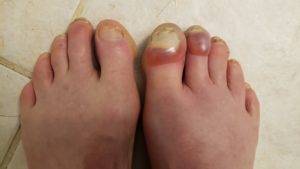
Chemical warmers don’t work that well when it’s cold out. For my training runs, I would stick chemical toe warmers to my warm socks before leaving the house. In the field, these need to be replaced after 5 hours or so, but the glue didn’t work and they never seemed to get warm. Mitigations might improve pre-warming them in my pocket and wearing sock liners that might keep the chemical pack in place. Similarly, hand warmers never seemed to get that warm. Probably I should rely on thicker gloves than I’m used to on my training runs, rather than relying on chemical hand warmers.
All other things being equal, I felt colder as the race continued. I never felt very cold for long (just when the wind would blow, and for a short time in my toes), and I was always quick to take out a new layer. But by the time I got to Dog Grave Lake, I was more bundled up than at the start of the race. Basically, I needed more clothing to be comfortable as the race continued, and I believe this is simply because I was generating less heat as I went on, partly because I was moving more slowly.
Clothing changes worked well. Fresh clean clothing made me really comfortable. Even though I wasn’t sweating much at all, the snow and a little perspiration meant that my clothing layers gradually got covered by snow, frost, and other moisture.
Notes on Gear
I’m not including links to the specific products since they seem to change rapidly. But for my notes and future reference, I offer a few comments on brands and specific gear that worked well for me.
I’m a huge fan of my thick Smartwool socks, and wear them throughout the cold season. I have multiple identical pairs, and bought three fluffy new pairs for the MYAU. These are classic edition extra cushion crew socks, which are in the trekking category. I also used Smartwool 150-weight long-sleeve shirts as my base layer (I had three of the same model, to swap during clothing changes).
My running shoes for the past couple of years have been New Balance Hierro trail running shoes. They do have a Gore-Tex version. These have a Vibram sole and are tough, without being too stiff or heavy. They have a generous toe box, which is important for my foot shape.
I have a lot of Patagonia gear. For MYAU this included running tights (my lower base layer), excellent balaclavas (you can breathe through them freely without getting clogged with ice), a vest (for core warmth) and my main top layer was an R1 Air zip-neck top – very comfy, and I had three of these for my clothing changes. I also had two other vests that were MEC brand.
The glove liners I wear are standard Army surplus green wool liners. These are inexpensive, tough, ambidextrous, and layer well under fleece mitts.
I have fleece mitts, head bands, neck gaitors and lots of other fleece stuff including heavier layers for top and bottom. Some is from Apocalypse Design (Fairbanks), some from Sportees (Whitehorse), some from Wintergreen (Ely, MN) – all highly recommended.
Ilana and I invested in a -60 Antarctic-grade sleeping bag from Wiggy’s, which is for mushing and other outings. This is a fantastic bag, but we might look for a down bag in the future because the Wiggy’s bag is very, very big. It basically took up half of my pulk, in the MYAU.
Rental gear from MYAU was top-quality. I rented a Montane 850-weight down parka, an RAB bivvy bag, and an Exped sleeping mat (R-6 with down fill, inflatable).
I bought a used pulk, harness, and bag from the race, so I could practice pulling a pulk. The pulk was from an Alaskan company, Air Frame Alaska. The harness and bag were from a different company.
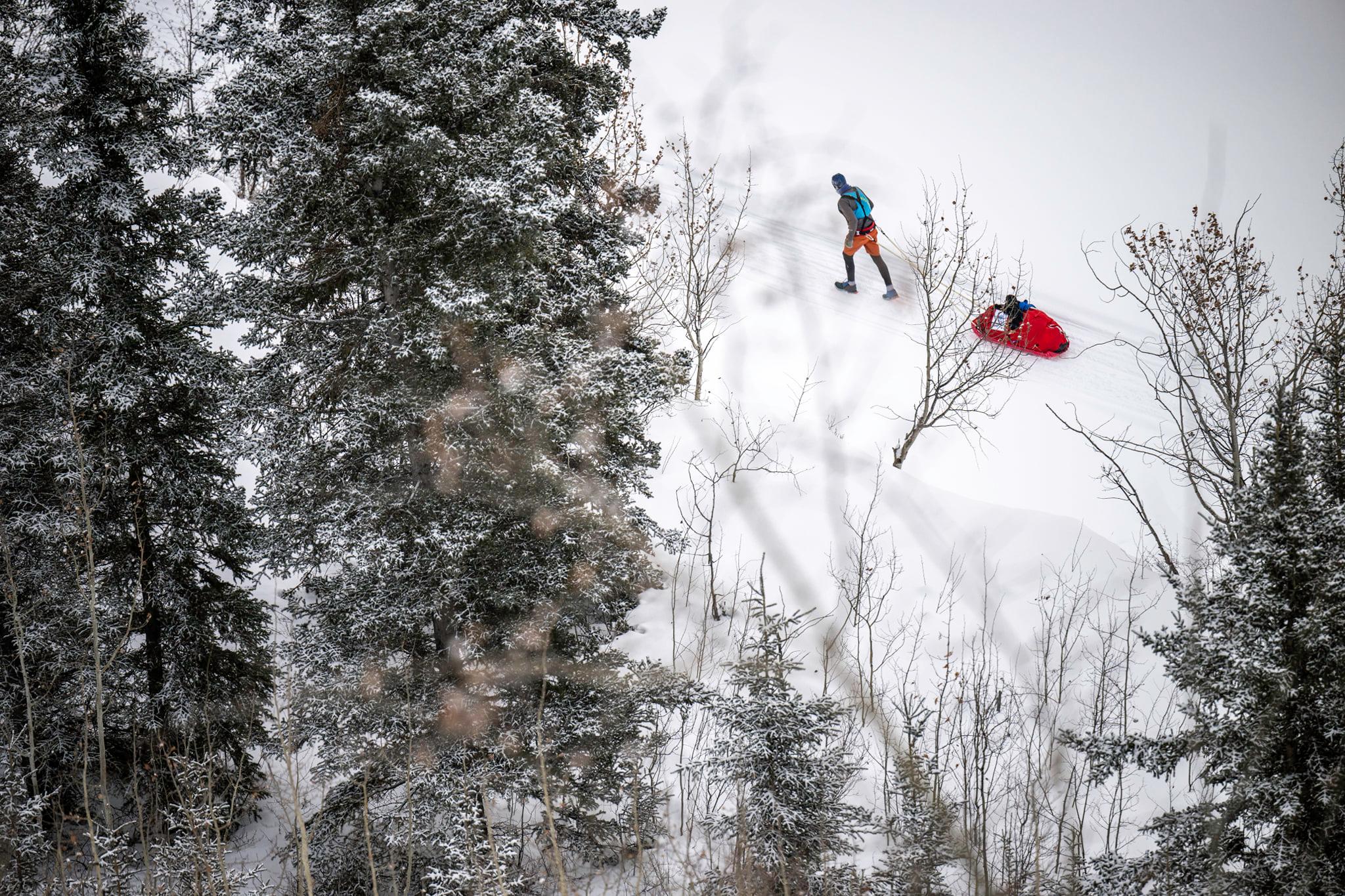
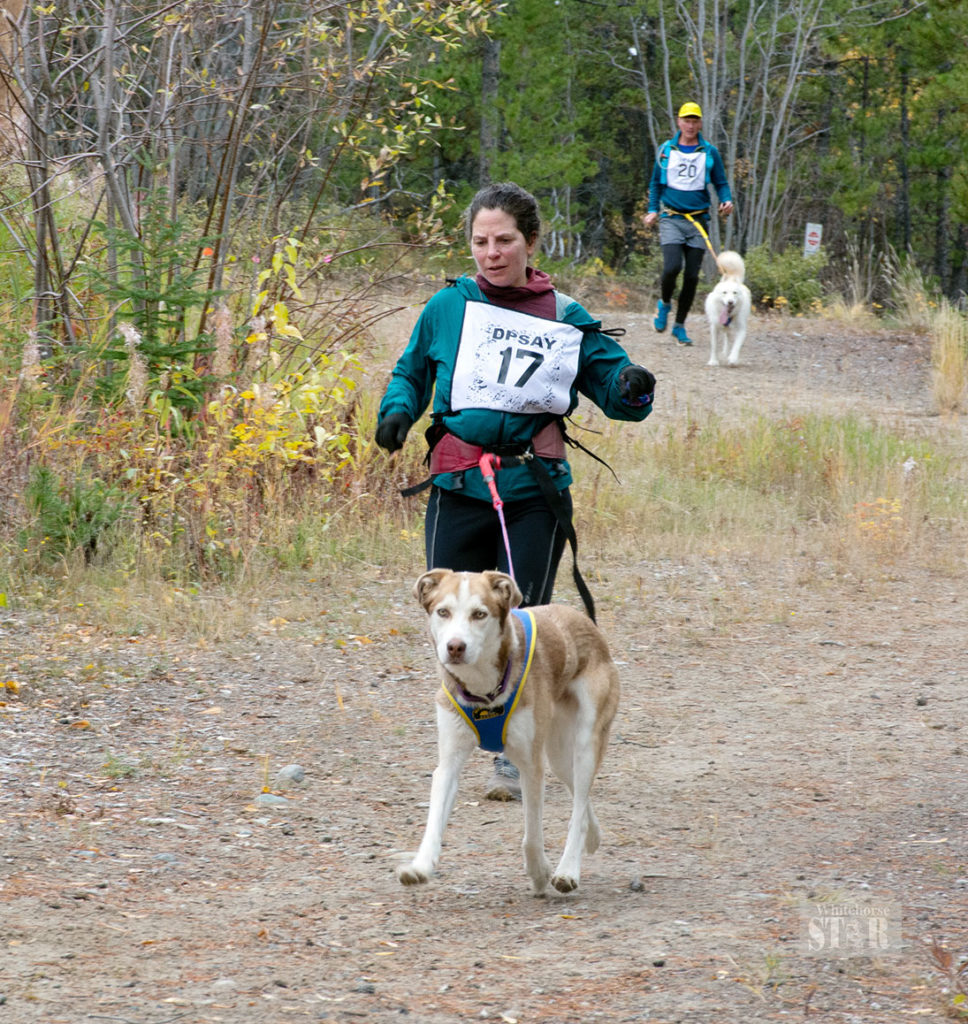
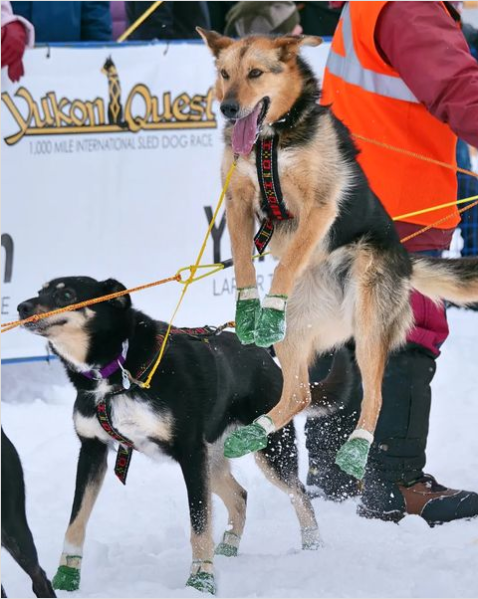
WOW Greg, I am blown away by this amazing article, what a vivid account bringing the reality of the challenge that you faced home to all of us who followed the dot. My nephew Aodh did the race and we all followed but had no idea of the effort that the preparation etc must have taken never mind the struggle during your ordeal. Well done to you, and thank you for this AMAZING piece of valuable work. Rita, Ireland
Great blog – enjoyed(?) reading it and am glad you ‘survived’ without too much damage! Good luck on your next adventure! My best to both of you.
Sridhar